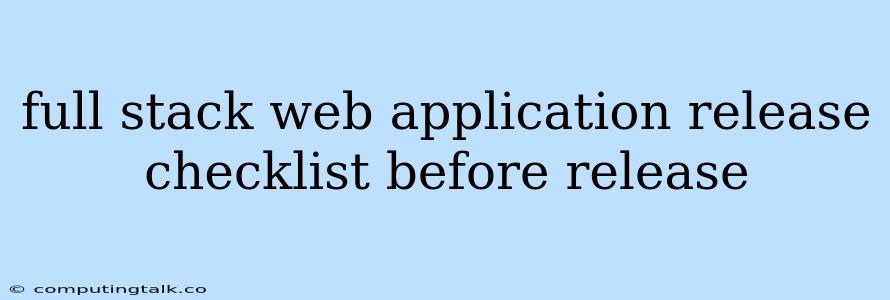A Comprehensive Full Stack Web Application Release Checklist Before Release
Releasing a new web application or a significant update is a crucial step in the development lifecycle. It requires careful planning, thorough testing, and a systematic approach to ensure a smooth and successful deployment. This checklist aims to guide developers through the essential steps needed before releasing a full-stack web application, helping to minimize potential issues and ensure a positive user experience.
1. Code Review and Code Quality
- Have all code changes been reviewed by peers? Code reviews are essential for identifying potential bugs, improving code readability, and ensuring adherence to coding standards.
- Have automated tests been run and passed? Automated tests (unit, integration, end-to-end) are critical for verifying that code changes have not introduced regressions or broken existing functionality.
- Has code complexity been analyzed and optimized? High code complexity can lead to maintainability issues and hidden bugs. Tools can help analyze and optimize code complexity.
- Have code style guidelines been adhered to? Consistent code style improves readability and maintainability.
2. Database and Data Integrity
- Have database schema changes been tested thoroughly? Schema changes can have far-reaching consequences, so thorough testing is essential.
- Have data migration scripts been tested and validated? Data migration can be complex, requiring careful testing to ensure data consistency and integrity.
- Have data backups been performed? Regular backups provide a safety net in case of accidental data loss or corruption.
3. Front-End Functionality and Performance
- Have all front-end features been thoroughly tested? This includes testing user interactions, form submissions, and data displays.
- Has the front-end code been optimized for performance? Page load times and responsiveness are crucial for user satisfaction.
- Have cross-browser compatibility tests been run? Ensure the application functions correctly across different web browsers and devices.
4. Back-End Functionality and Security
- Have all back-end APIs been tested and documented? API documentation is crucial for developers who need to integrate with your application.
- Have security vulnerabilities been addressed? Perform security audits and penetration testing to identify and mitigate potential vulnerabilities.
- Have authentication and authorization mechanisms been tested and validated? Secure authentication is essential for protecting sensitive user data.
- Has data sanitization been implemented to prevent injection attacks? This is critical for protecting the application against malicious code injection.
5. Infrastructure and Deployment
- Have the necessary infrastructure resources been provisioned? Ensure sufficient compute, storage, and network resources for the application.
- Have deployment scripts been tested and validated? Automate deployment processes for consistency and efficiency.
- Has the staging environment been configured to mimic production? Testing in a production-like environment helps identify potential issues before going live.
- Has a rollback plan been defined in case of issues? A clear rollback plan allows for quick recovery if something goes wrong during the release.
6. Monitoring and Analytics
- Have monitoring tools been set up to track application performance? Monitoring helps identify performance bottlenecks and other issues in real-time.
- Have analytics tools been integrated to track user behavior and engagement? Analytics provide valuable insights into how users interact with the application.
7. Communication and Documentation
- Has the release been communicated to stakeholders and users? Clear communication about new features and updates helps manage expectations.
- Have release notes been prepared and made available? Release notes provide a detailed overview of changes and bug fixes.
- Has documentation been updated to reflect changes in the application? Keeping documentation up-to-date ensures users have access to the latest information.
8. Post-Release Monitoring and Support
- Have post-release monitoring and support processes been established? Monitor the application for any issues that may arise after the release.
- Has a communication channel been set up for user feedback and bug reports? Collect user feedback to identify and address potential issues.
9. Checklist for ReactJS Applications
- Are all components and dependencies up-to-date? Keep dependencies current to benefit from security updates and performance improvements.
- Has the code been analyzed for potential performance issues? Use tools like React DevTools to identify and optimize performance bottlenecks.
- Are there any known compatibility issues with the current ReactJS version? Check for any breaking changes or known compatibility issues.
10. Checklist for NodeJS Applications
- Has the NodeJS application been thoroughly tested on the target server environment? Ensure compatibility and performance in the production environment.
- Have security best practices been followed in the NodeJS codebase? Address potential vulnerabilities through appropriate security measures.
- Is the NodeJS codebase using an updated and secure version of the framework? Keep the NodeJS framework up-to-date for security patches and bug fixes.
Conclusion
A comprehensive release checklist like the one presented here is essential for ensuring a smooth and successful launch of your full-stack web application. It provides a structured approach to identifying and addressing potential issues, minimizing downtime, and maximizing user satisfaction. By following this checklist, developers can significantly reduce the risk of unexpected problems during the release process and ensure a positive experience for both users and stakeholders.
